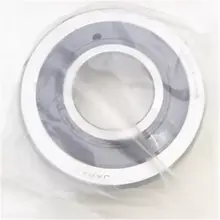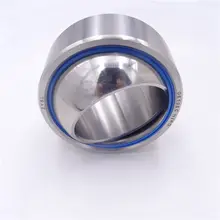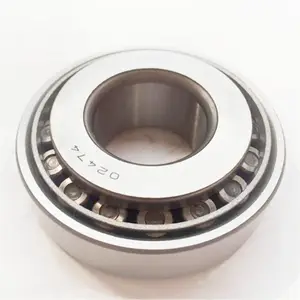The designation "bearing 201" refers to a class of bearings engineered to facilitate rotational movement between disparate components. The 201 bearing is a distinct variant within this class, acclaimed for its precision engineering, robustness, and adaptability. These bearings are pivotal in a multitude of machines, playing an essential role in diminishing friction and managing stress, thereby guaranteeing seamless functionality.
Types and Structure of Bearing 201
The bearing 201 family includes a variety of types, each tailored with specific features to cater to an extensive range of uses. Pillow block bearings, such as the UCP 201, are noted for their sturdiness and straightforward mounting, commonly employed in conveyor systems and stationary shaft machinery. Track roller bearings, including the LR 201 NPPU and LV 201 ZZ, boast thick-walled outer rings that enable them to withstand substantial radial forces, rendering them suitable for rigorous tasks like cam drives and conveyance systems. The assortment within the 201 bearing series guarantees a tailored bearing solution for nearly any load scenario, whether radial, axial, or a combination thereof.
The architecture of these bearings is carefully crafted to deliver peak performance. A typical bearing 201 is composed of an inner and outer ring, balls or rollers, and a cage that secures the rolling elements. The inner ring is designed to fit closely around the shaft, channeling the load to the balls or rollers. The outer ring anchors the assembly within its housing. The rolling elements, be they balls or rollers, are the core of the bearing, enabling fluid rotation with minimal friction. The cage is instrumental in preserving the spacing among the rolling elements, preventing collisions during operation that could precipitate increased wear and failure.
Materials and Precision Rating in Bearing 201 Manufacturing
The materials employed in the bearing 201 series span chrome steel, Gcr15, stainless steel, carbon steel, and bearing steel. Chrome steel is preferred for its exceptional fatigue resistance and longevity. Gcr15, a high-carbon chromium bearing steel, is prized for its consistency and resistance to wear, making it ideal for precision bearings. Stainless steel is selected for its anti-corrosive properties, whereas carbon steel provides a cost-effective alternative for less intensive applications. The material selection is a pivotal factor influencing the bearing's efficacy, lifespan, and environmental compatibility.
Each material confers distinct advantages to the bearing 201. Chrome steel ensures an excellent surface finish and formidable load capacity. Gcr15 is distinguished by its consistent hardness and superior wear resistance, vital for preserving the bearing's precision over time. Stainless steel bearings are inherently resistant to corrosion, optimal for use in damp or corrosive settings such as food processing or marine applications. Carbon steel, though not as enduring as other materials, presents a budget-friendly option for scenarios with moderate loads and speeds and less corrosive environments.
Business Usages and Applicable Industries for Bearing 201
Bearing 201 products find utility across a diverse spectrum of industries, each deriving benefits from their particular features. In manufacturing facilities, these bearings are indispensable for the fluid operation of machinery, leading to heightened productivity. Machinery repair shops value them for their longevity and ease of substitution. In construction, the 201 bearing's capacity to withstand substantial loads renders it a vital element in heavy equipment. Retailers, building material outlets, and agricultural operations rely on these bearings for equipment that demands consistent and dependable performance. The versatility of the 201 bearing series significantly contributes to business value by augmenting the efficiency and dependability of machinery in various contexts.
In certain sectors, the bearing 201 is a crucial component that underpins the overall success of the enterprise. For example, in agriculture, these bearings are integrated into a plethora of farm machinery, from tractors to conveyor systems, ensuring the smooth functioning of equipment critical for sowing, reaping, and processing crops. In the textile industry, the high-speed capabilities of the 201 bearing are essential for the operation of spinning and weaving machines, directly influencing production rates and the quality of the end products.
Functions and Features of Bearing 201
The fundamental role of a bearing 201 is to support and guide rotating parts, delivering high precision and reducing friction. These bearings are adept at handling both radial and axial loads, offering versatility in their application. The 201 bearing series is characterized by its capacity for high-speed operation, a critical attribute for many contemporary machinery applications. The precision rating of P6 or P0 denotes the bearing's proficiency in sustaining performance across various operational conditions, contributing to the machine's overall dependability.
The distinctive attributes of the bearing 201 series encompass their engineered design for optimized load distribution, which prolongs the bearing's service life. The smooth operation of the rolling elements and the precision of their manufacture underpin the bearing's ability to function at elevated speeds with minimal noise and vibration. This is particularly significant in applications where noise reduction is imperative, such as in medical devices or office equipment.
Benefits and Advantages of Using Bearing 201
Employing bearing 201 in machinery yields a multitude of advantages, including diminished maintenance expenses owing to their extended service life. The high-speed attribute of the 201 bearing bolsters productivity by allowing machinery to run at accelerated rates without sacrificing performance. The bearings' proficiency in managing both radial and axial loads facilitates more innovative machine design and can result in cost reductions by minimizing the need for additional components.
The bearing 201 series also provides the benefit of effortless installation and replacement, which curtails downtime and maintenance efforts. Their adaptability to a range of temperature conditions and operational scenarios renders them a dependable option for a wide array of applications. Users reap the rewards of employing 201 bearings, such as enhanced machine efficiency, reduced energy consumption, and overall long-term cost savings.
How to Choose and Install Bearing 201
Choosing the right bearing 201 entails evaluating the application's load demands, desired precision, and environmental factors. Decisions regarding material selection and the appropriateness of a single or double row configuration are also crucial. Installation demands accuracy; bearings must be mounted cleanly and without exertion. Proper alignment is essential to avert undue strain and wear. Regular upkeep, including lubrication and checks, is vital for ensuring longevity and peak performance.
During the installation of a bearing 201, it is imperative to maintain a clean environment to avoid contamination, which can precipitate early bearing failure. The installation process should be executed with suitable tools to prevent damage to the bearing surfaces. For maintenance, a regimen should be devised based on the operational conditions and the manufacturer's guidelines. Cleaning should be conducted with proper solvents, and lubrication should be applied with the correct lubricant type and quantity.
What are the key considerations when selecting a bearing 201 for my machinery?
In selecting a bearing 201, it is important to consider the type and magnitude of the load, the operational velocity, the precision requirements, and the environmental conditions in which the bearing will function. Assessing these elements ensures the choice of a bearing that aligns with the specific demands of your machinery.
How does the material of a bearing 201 affect its performance?
The material composition of a bearing 201 significantly influences its performance, with various materials offering different degrees of strength, endurance, and resistance to environmental factors. Chrome steel and stainless steel are favored for their robustness and longevity, while bearing steel is selected for applications subject to high stress.
Can bearing 201 be customized to fit non-standard applications?
Indeed, bearing 201 can be tailored to accommodate the requisites of non-standard applications. Customizations may involve unique dimensions, specialized materials, or altered precision ratings to ensure seamless integration with particular machinery or operational conditions.



































 浙公网安备 33010002000092号
浙公网安备 33010002000092号 浙B2-20120091-4
浙B2-20120091-4